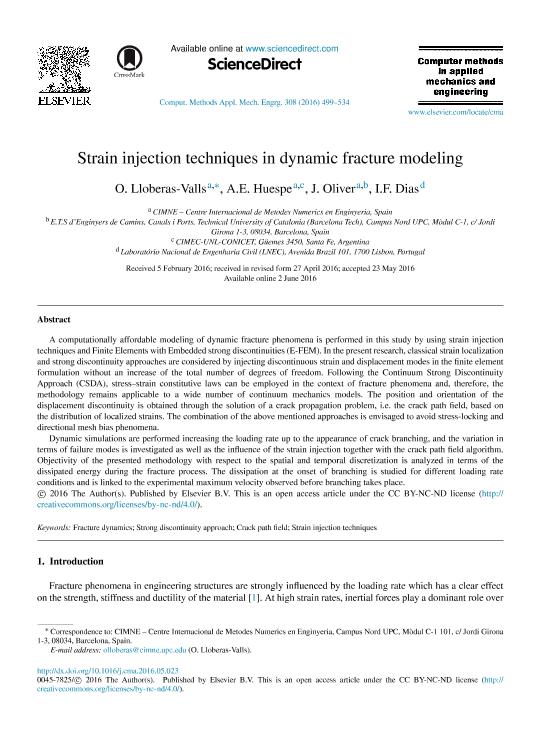Artículo
Strain injection techniques in dynamic fracture modeling
Fecha de publicación:
08/2016
Editorial:
Elsevier Science Sa
Revista:
Computer Methods in Applied Mechanics and Engineering
ISSN:
0045-7825
Idioma:
Inglés
Tipo de recurso:
Artículo publicado
Clasificación temática:
Resumen
A computationally affordable modeling of dynamic fracture phenomena is performed in this study by using strain injection techniques and Finite Elements with Embedded strong discontinuities (E-FEM). In the present research, classical strain localization and strong discontinuity approaches are considered by injecting discontinuous strain and displacement modes in the finite element formulation without an increase of the total number of degrees of freedom. Following the Continuum Strong Discontinuity Approach (CSDA), stress–strain constitutive laws can be employed in the context of fracture phenomena and, therefore, the methodology remains applicable to a wide number of continuum mechanics models. The position and orientation of the displacement discontinuity is obtained through the solution of a crack propagation problem, i.e. the crack path field, based on the distribution of localized strains. The combination of the above mentioned approaches is envisaged to avoid stress-locking and directional mesh bias phenomena. Dynamic simulations are performed increasing the loading rate up to the appearance of crack branching, and the variation in terms of failure modes is investigated as well as the influence of the strain injection together with the crack path field algorithm. Objectivity of the presented methodology with respect to the spatial and temporal discretization is analyzed in terms of the dissipated energy during the fracture process. The dissipation at the onset of branching is studied for different loading rate conditions and is linked to the experimental maximum velocity observed before branching takes place.
Archivos asociados
Licencia
Identificadores
Colecciones
Articulos(CIMEC)
Articulos de CENTRO DE INVESTIGACION DE METODOS COMPUTACIONALES
Articulos de CENTRO DE INVESTIGACION DE METODOS COMPUTACIONALES
Citación
Lloberas Valls, Oriol; Huespe, Alfredo Edmundo; Oliver, J.; Dias, I.F.; Strain injection techniques in dynamic fracture modeling; Elsevier Science Sa; Computer Methods in Applied Mechanics and Engineering; 308; 8-2016; 499-534
Compartir
Altmétricas




